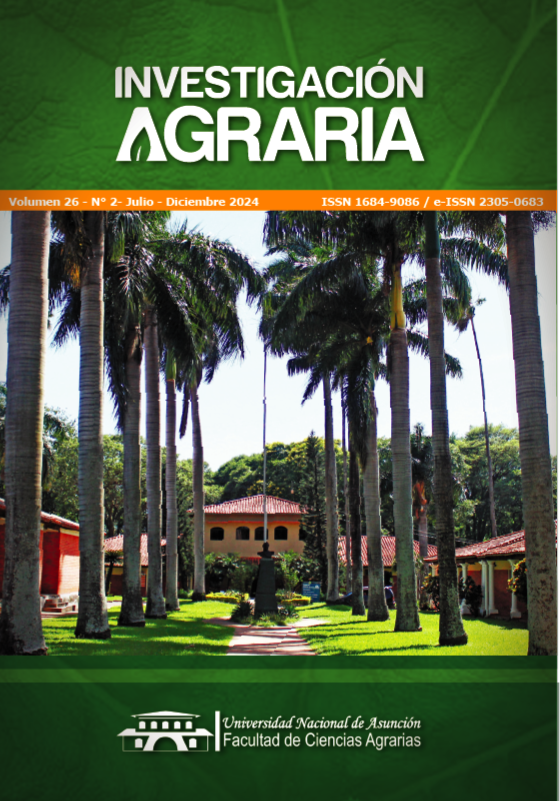Agronomic traits and oil content of sesame varieties in eastern Paraguay
DOI:
https://doi.org/10.18004/investig.agrar.2024.diciembre.2602810Palabras clave:
Sesamum indicum L., ajonjolí, agricultura familiar campesinaResumen
En Paraguay, el sésamo cumple una función social en el medio rural, debido a que es producido principalmente por pequeños agricultores. Sin embargo, aún son escasas las informaciones que identifiquen variedades con altos rendimientos. Este estudio tuvo como objetivo evaluar las características agronómicas y el contenido de aceite de cinco variedades de Sesamum indicum L. Los experimentos se realizaron en Saltos del Guairá e Ybyrarobana en la campaña agrícola 2022/23. El diseñoexperimental fue de bloques al azar con cinco repeticiones y cinco tratamientos correspondientes a cinco variedades de sésamo (Inia, Negro, KO7, SH1 y Escoba) en cada experimento. Las características evaluadas fueron altura de planta, número de cápsulas, peso de mil granos, rendimiento de grano y porcentaje de aceite enlos granos. Se observó, en la variedad Escoba, la mayor altura de planta (174,50 cm), y las variedades Inia y Negro presentaron el mayor valor en peso de mil granos: 3,20 y 3,02 g, respectivamente. Para las variables número de cápsulas, productividad y contenido de aceite no se observaron diferencias.Descargas
Métricas
Citas
Araújo, F. S., Borges, S. R. S., Silva, G. Z., Araújo, L. H. B., e Torres, E. J. M. (2014). Doses de fósforo no crescimento inicial do gergelim cultivado em solução nutritiva. Revista Tecnologia & Ciência Agropecuária, 8(2), 41–47.
Beltrão, N. E. M., Vieira, D. J. (2001) O agronegócio do gergelim no Brasil. Brasília: EMBRAPA, 348 p.
Boureima, S., Eyletters, M., Diouf, M., Diop, T. A., & Van Damme, P. (2011). Sensitivity of seed germination and seedling radicle growth to drought stress in sesame (Sesamum indicum L.). Research Journal of Environmental Sciences, 5(6), 557–564.
Ministério da Agricultura, Pecuária e Abastecimiento (2009). Regras para análise de sementes. Brasília. Ministério da Agricultura, Pecuária e Abastecimento/Secretaria de Defesa Agropecuária. 399 p.
Cabral, T. M. L. y Oviedo De Cristaldo, R. M. (2008). Caracterización agronómica de cuatro variedades de sésamo (Sesamum indicum L.), sembradas en el departamento Central. Investigación Agraria, 10(2), 10-15
Cavalcante, F. J. de A. (Coord.). (2008). Recomendações de adubação para o estado de Pernambuco: 2ª aproximação (2nd ed.). Recife, PE: IPA, 89-103 p.
Enciso, V. y Leon, L. (2022). Sésamo. Panorama local y regional. Vol. 18. Facultad de Ciencias Agrarias, Universidad
Nacional de Asunción.
Egbekun, M. K. & Ehieze, M. U. (1997). Proximate composition and functional properties of full-fat and defatted beniseed (Sesamum indicum L.) flour. Plant Foods for Human Nutrition, 51(1), 35–41.
FAO. (2022). FAO statistical yearbook. Food and Agriculture Organization (FAO) of the United Nations. Available at http://www.fao.org/faostat/en/#data/QC
International Union of Pure and Applied Chemistry (IUPAC). (1979) Standard methods for the analysis of oils, fats and derivatives. Oxford: IUPAC, 1360p.
Mazzani, B. (1999). Investigación y tecnología del cultivo del ajonjolí en Venezuela. Caracas: Ediciones del Consejo Nacional de Investigaciones Científicas y Tecnológicas.. Disponible en https://blogtextilesyoleaginosasfagroucv. files.wordpress.com/2016/02/investigacic3b3n-ytecnologia-del-cultivo-del-ajonjoli-en-venezuela.pdf
Moreno, P. (2006). Adaptación de cuatro variedades de sésamo (Sesamum indicum L.) en el Distrito de San Roque González de Santa Cruz, Departamento de Paraguari (Doctoral dissertation). San Lorenzo: CIA, FCA, UNA.
Oviedo De Cristaldo, R. (2007). Introducción y selección de cultivares de sésamo. In Jornada Técnica-Científica del Cultivo Del Sésamo (pp. 2–8). San Lorenzo: CIA, FCA, UNA.
Olowe, V. I., & Adeoniregun, O. A. (2010). Seed yield, yield attributes, and oil content of newly released sesame (Sesamum indicum L.) varieties. Archives of Agronomy and Soil Science, 56(2), 201–210.
Paredes Alfonzo, R., y Rodríguez Espínola, H. N. (2013). Caracterización de plantas individuales de cultivares de sésamo (Sesamun indicum L.) En siembra tardía. Investigación Agraria, 6(1), 20–26. Recuperado a partir de https://www.agr.una.py/revista/index.php/ria/article/
view/200
Queiroga, V. de P., Gondim, T. M. de S., Almeida, F. de A. C., e Albuquerque, E. M. B. de (Eds.). (2017). Gergelim orgânico: Tecnologia de produção (1st ed.). Campina Grande: AREPB.
Torres, M. C. y De Cristaldo, R. O. (2008). Caracterización agronómica de cuatro variedades de sésamo (Sesamum indicum L.), sembradas en el departamento Central. Investigación Agraria, 10(2), 10–15.
Silva, J. C. A., Fernandes, P. D., Bezerra, J. R. C., Arriel, N. H. C., e Cardoso, G. D. (2014). Crescimento e produção de genótipos de gergelim em função de lâminas de irrigação. Revista Brasileira de Engenharia Agrícola e Ambiental, 18(4), 408–416.
Zech-Matterne, V., Tengberg, M. & Van Andringa, W. (2015). Sesamum indicum L. (Sesame) in 2nd Century BC Pompeii, Southwest Italy, and a Review of Early Sesame Finds in Asia and Europe. Vegetation History Archaeobotany, 24, 673–681.
Descargas
Publicado
Cómo citar
Número
Sección
Licencia
Derechos de autor 2025 Milciades Ariel Melgarejo Arrúa, Belén Diaz Blanco, Patricia Colman Ribelatto, Marcos Mendoza, Americo Aguilera Sosa, Diosnel Amarilla, Ever Maidana, Elida Peralta, Lider Ayala Aguilera, Modesto Da Silva Oviedo

Esta obra está bajo una licencia internacional Creative Commons Atribución 4.0.
Todo el contenido de esta revista, está bajo Licencia de Atribución Creative Commons.









 Todo el contenido de esta revista, está bajo
Todo el contenido de esta revista, está bajo 